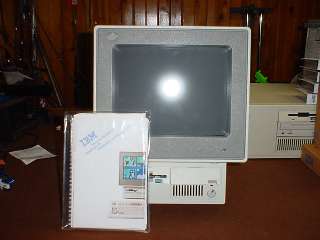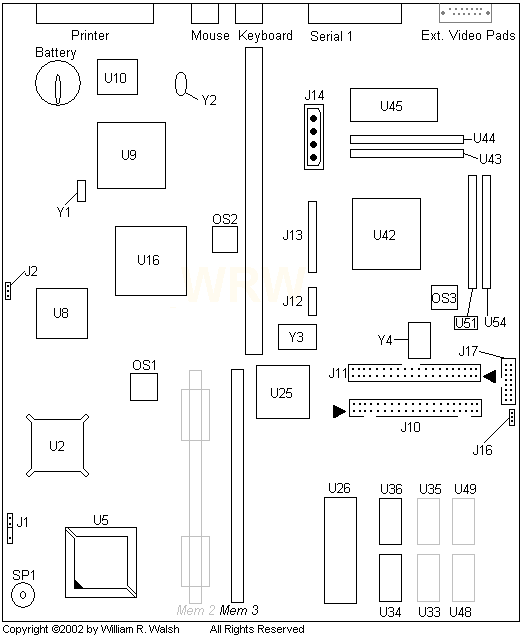Model 25SX
The Model 25SX is the highest performance Model 25 there is.

You could think of it as a "95 series" Model 25, despite the fact that it is an 8525. With onboard IDE, SVGA video, and up to 12MB installed RAM, this 25 is by far the most powerful around, except for the 7386 and Reply planar upgrades.
Features
Planar
Ports Trivia
386SX Underclocked---or not?
Features (on mine)
Intel 80386SX-20 MHz CPU
1.44 Floppy (possible 2.88MB support)
1MB RAM
No Hard Disk (yet)
3 ISA Slots (2 standard, one "flipped", all 16 bit)
Planar

Components:
U2 - Intel i386SX-20 (Underclocked to 16MHz)
U5 - 80387SX-16 Socket
U8 - VLSI VL82C304
U9 - VLSI VL82C305-FC
U10 - Intel i8042 Keyboard Controller (Interesting package--never seen that kind before!)
U16 - OKI 92F1173
U25 - Intel 82077AA FDC
U26 - IBM BIOS P/N 87F4794
U33 - Memory Chip solder pads (populated on non "K" models)
U34 - Memory Chip Hitachi HM514900JP8
U32 - Memory Chip solder pads (populated on non "K" models)
U42 - IBM SVGA 84F7985 (same as on the 512K SVGA/A, 40SX and 57sxx planars)
U43 - Toshiba TC511665BZ-80 VRAM ZIP
U44 - Toshiba TC511665BZ-80 VRAM ZIP
U45 - Inmos IMSG171P Video RAMDAC
U48 - Memory chip solder pads (populated on non "K" models)
U49 - Memory chip solder pads (populated on non "K" models)
U51 - Toshiba TC511665BZ-80 VRAM ZIP
U54 - Toshiba TC511665BZ-80 VRAM ZIP
J1 - Possible speaker output? Jumpered on 1-2.
J2 - Power On Password Clear
J10 - IDE
J11 - Floppy Disk Drive Cable
J12 - Power Connector
J13 - Power Connector
J14 - 4 pin Molex male connector for hard disk drive power
J16 - Unknown Function
Y1 - 32.768 kHz Hardware RTC OSC
Y2 - 14.31818 Software RTC OSC
Y3 - 25.175MHz OSC (For i82077AA?)
Y4 - 28.322MHz OSC (For what?)
OS1 - 32.0000MHz OSC for i386SX (it's underclocked, maybe one could use a 40MHz OSC?)
OS2 - 48.0000MHz OSC (for what?)
OS3 - 41.5390MHz OSC (for what?)
Items drawn in gray are not populated on the "K" series planar. MEM 2 is not populated with a SIMM socket on any planar, but on non "K" planars there are two more memory chips at this location for a total of 4MB on the planar. 2x512K chips, in banks of two = 4x1MB onboard RAM.
An attempt by Phil Mallory to install a SIMM socket at this location failed with the machine experiencing odd memory errors and failure of diagnostics. The system memory controller may be designed to take only the soldered memory packages and not two SIMMs. It might lack the decoding hardware to properly handle two SIMMs?
Ports Trivia
The "Ext. Video Pads" in the planar drawing above are for a separate video adapter installed in the system that allowed teachers and students to work on one computer at the same time. Kxx systems don't have anything except soldering pads in this spot.
The "flipped" ISA slot on the other side of the riser card is used for an IBM Ethernet or Token Ring adapter that fits in a special cutout on the back of the system. It might be possible to hack a standard Ethernet or Token Ring card to go in there. You might not even need to hack it if you use a small "half height" card.
Mystery Of U42/IBM Extended VGA or SVGA Controller
This chip is the same as the one that's used on the 512K Server SVGA card. This chip also appears on the 56/57 SX/SLC planars, as well as the Model 40SX. The Model 25 even comes with all the VRAM needed to use the SVGA modes that the chipset provides. I know it can do 640x480x256 and 800x600x16 for sure.
Using the IBM VESA driver for the 512K Server SVGA card, I was able to kick it up into 256 colors at 640x480 and 16 colors at 800x600, at which point the 25SX's built in screen was unable to sync properly.
So at least the chipset is willing and able if it has the needed VRAM as the 25 does. It doesn't seem that anyone has developed drivers for any OS except possibly OS/2 and the VESA driver for DOS. I don't know yet if the chipset used emulates any other SVGA or not. It was developed by Texas Instruments for IBM...are there any other TI-based SVGA adapters out there that might have drivers I could try?
Contact me if you know.
Underclocked 386SX--Or Not???
Long story short, the IBM specs may be lying to you. The 25SX can have a 16MHz CPU clocked at 16MHz, a 20MHz CPU clocked at 16, and finally, 20MHz CPUs clocked at 20MHz. (Gee, I wonder if any were ever overclocked?)
Special thanks need to go out to bobwatts over in Diesel Chevette World. He sent me my first and only example of a true 20MHz 25SX.
So why does all this matter to you? Because it may mean the difference between a CPU upgrade that clips over the soldered i386SX CPU being an option you can use to upgrade the processor in your 25SX or not.
Very few 16MHz parts (and even fewer as used in many PS/2s) have the ability to be shut down with a so-called disable pin on the CPU. Your CPU must be stepping 2308h or higher if it's a 16MHz unit. All 20MHz and greater i386SX CPUs have the disable pin that's required to use an upgrade CPU.
(And who says the 25SX can't compare to the Model 9x with all its CPU complexes?!)
Go Back To Model 25 Page >
Go Back To Computers Collection >